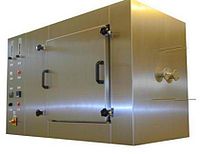Difference between revisions of "Drying Ovens"
Jump to navigation
Jump to search
PurplePen19 (talk | contribs) |
|||
| (2 intermediate revisions by one other user not shown) | |||
| Line 1: | Line 1: | ||
[[Category:Drying]]{{Knoppen}} | [[Category:Drying]]{{Knoppen}} | ||
[[File:Drying_Ovens.jpg|thumb|200px|right|Drying Ovens]] | [[File:Drying_Ovens.jpg|thumb|200px|right|Drying Ovens]] | ||
'''Drying ovens''' are used for drying and heat-treating materials in a fresh-air or protective gas atmosphere (hydrogen or inertgas) for drying materials containing solvents which do build an explosive mixture in contact with air according to ATEX (ATEX 100a), 94/9/EC, EN1539. Drying cabinets can be heated in the following ways: Direct, electrically or by steam and indirect, i.e. secondary via heat carrier supply system, like thermal oil or hot water. Drying Ovens can also be designed with an additional cooling system, to reduce the cooling phase and the charging temperature. | |||
''' | |||
Latest revision as of 01:46, 23 July 2013
Drying ovens are used for drying and heat-treating materials in a fresh-air or protective gas atmosphere (hydrogen or inertgas) for drying materials containing solvents which do build an explosive mixture in contact with air according to ATEX (ATEX 100a), 94/9/EC, EN1539. Drying cabinets can be heated in the following ways: Direct, electrically or by steam and indirect, i.e. secondary via heat carrier supply system, like thermal oil or hot water. Drying Ovens can also be designed with an additional cooling system, to reduce the cooling phase and the charging temperature.
